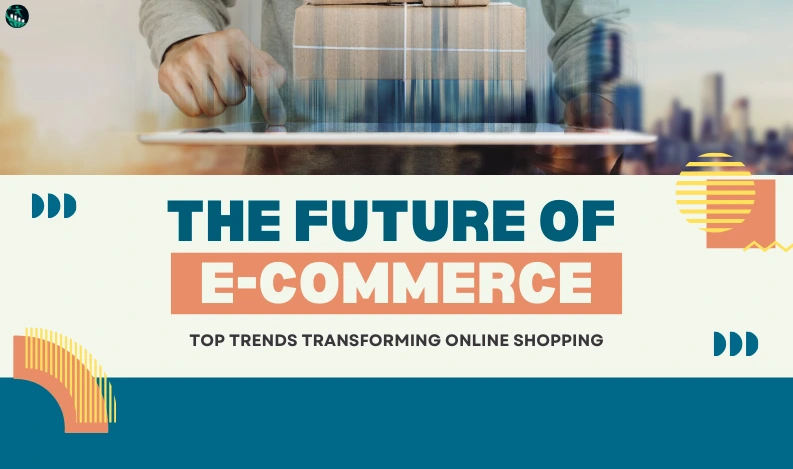
The Future of E-Commerce: Top Trends Transforming Online Shopping
E-commerce continues to redefine how we shop, with groundbreaking trends that reshape consumer expectations and business strategies. From personalized experiences powered by AI to seamless social commerce, the online shopping landscape is poised for transformation. Let’s explore the key trends shaping the future of e-commerce and how businesses can leverage them to create exceptional customer experiences and stay ahead of the competition.
1. Personalized Shopping Powered by Artificial Intelligence (AI)
Artificial Intelligence (AI) has become an indispensable part of e-commerce, bringing personalization to a whole new level. AI enables online stores to analyze customer behavior, anticipate needs, and offer products tailored to individual preferences.
- Why It Matters: Personalization creates a connection between the customer and the brand, enhancing loyalty and driving more sales. By delivering relevant content and product recommendations, businesses can engage customers on a deeper level.
- How to Use It:
- Smart Product Recommendations: E-commerce giants like Amazon utilize AI to suggest products based on a user’s search history and past purchases, driving conversion rates.
- Automated Customer Support: AI-powered chatbots provide instant answers to customer queries, boosting satisfaction and efficiency.
With AI, businesses can turn data into actionable insights, building a seamless, personalized shopping journey that resonates with each individual.
2. Voice Commerce and Conversational Shopping
Voice search is revolutionizing e-commerce by providing a hands-free, conversational way to shop. As smart speakers and voice assistants like Alexa and Google Assistant become more common, consumers are increasingly comfortable using voice commands to find and purchase products.
- Why It Matters: Voice commerce offers speed and convenience, particularly for mobile users, making it an ideal solution for today’s busy consumer.
- How to Optimize for Voice Commerce:
- Adopt Natural Language: People tend to use conversational language in voice searches. Including natural, question-based keywords (e.g., “Where can I buy affordable organic coffee?”) improves search visibility.
- Optimize for Local Search: Many voice searches are local. Ensure your Google My Business listing is up-to-date to capture these “near me” queries.
Voice commerce allows customers to easily interact with your brand, making it an excellent way to increase engagement and streamline the purchase process.
3. Augmented Reality (AR) for Immersive Product Experiences
Augmented Reality (AR) is enhancing the online shopping experience by allowing customers to visualize products in real-life contexts. AR technology enables shoppers to “try on” clothes, preview furniture in their home, and even see how makeup products would look on their skin tone.
- Why It Matters: AR reduces the uncertainty of buying online, boosting confidence in purchase decisions and potentially reducing return rates.
- Implementation Ideas:
- Virtual Fitting Rooms: Fashion brands are using AR to allow customers to visualize how clothes will look on them before buying.
- Home Décor Previews: Brands like IKEA enable customers to see how furniture will fit in their space, making it easier to make informed decisions.
By embracing AR, businesses can provide a truly interactive shopping experience that sets them apart from competitors.
4. Sustainability and Ethical Shopping Practices
Today’s consumers are more environmentally conscious, and they expect brands to reflect those values. Businesses are responding by adopting sustainable practices, from eco-friendly packaging to transparent supply chains, making environmental responsibility a core part of their brand identity.
- Why It Matters: Shoppers increasingly support brands that prioritize environmental impact and ethical sourcing, making sustainability a key differentiator.
- How to Implement Sustainable Practices:
- Eco-Friendly Packaging: Reduce your environmental footprint with recyclable, compostable, or minimal packaging options.
- Transparency in Sourcing: Highlight the origins and ethical standards of your products, building trust with eco-conscious consumers.
By focusing on sustainability, e-commerce brands not only meet customer expectations but also contribute to a positive social impact, enhancing brand reputation and loyalty.
5. Subscription Services for Convenience and Value
Subscription models offer a win-win for both businesses and customers, providing recurring revenue for companies and convenience for consumers. From curated boxes to auto-replenishment options, subscriptions help companies foster brand loyalty and encourage repeat purchases.
- Why It Matters: Subscription services increase customer retention and create a predictable revenue stream. They allow businesses to curate a unique experience for their customers, keeping them engaged over time.
- Popular Examples:
- Curated Boxes: Beauty boxes and food subscription services, such as Birchbox and HelloFresh, offer customers a convenient, personalized experience that builds loyalty.
- Membership Benefits: Programs like Amazon Prime offer exclusive discounts, fast shipping, and other perks, encouraging customers to shop more frequently.
Offering a subscription option can help e-commerce brands turn occasional buyers into dedicated customers, boosting lifetime value and customer satisfaction.
6. Social Commerce and In-App Shopping
Social media is no longer just a place for content sharing; it’s a powerful sales channel where consumers can discover, engage with, and buy products without leaving their favorite apps. Platforms like Instagram, TikTok, and Facebook are adding shopping features that allow consumers to purchase products directly from posts and stories.
- Why It Matters: Social commerce integrates shopping into users’ everyday experiences, making it easier to discover and purchase products in a natural, engaging way.
- Tips for Success:
- Create Shoppable Content: Enable shopping tags on your social posts, allowing customers to view product details and make purchases with just a tap.
- Collaborate with Influencers: Team up with influencers who align with your brand to drive awareness and create authentic endorsements that resonate with their followers.
Social commerce reduces the gap between discovery and purchase, allowing businesses to engage with customers directly where they spend most of their time.
Conclusion
The future of e-commerce promises a more personalized, convenient, and responsible shopping experience, with trends like AI-driven personalization, AR, and social commerce paving the way. By adopting these trends, businesses can connect with customers on a deeper level and drive growth in a competitive landscape. Embracing these innovations today can set brands up for long-term success, delivering an e-commerce experience that resonates with the modern consumer.
Also Read:-



Recent Comments: